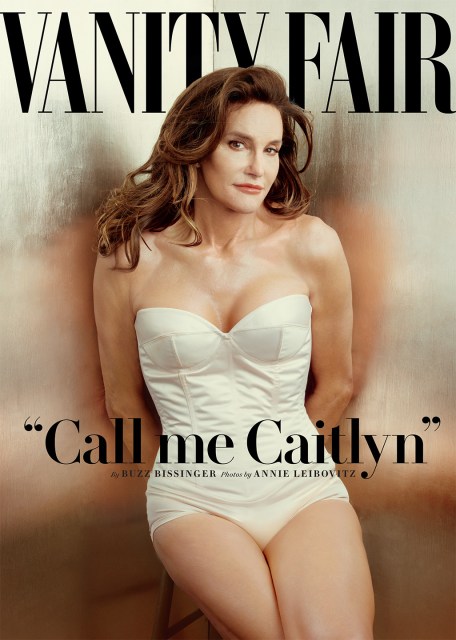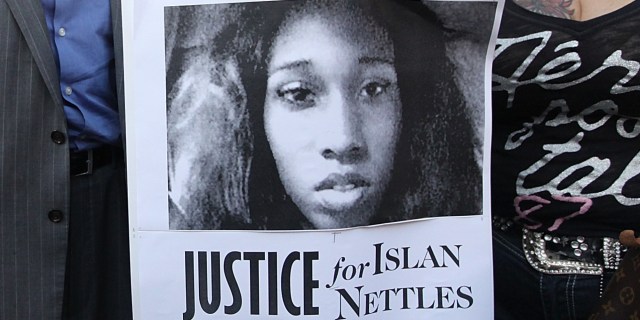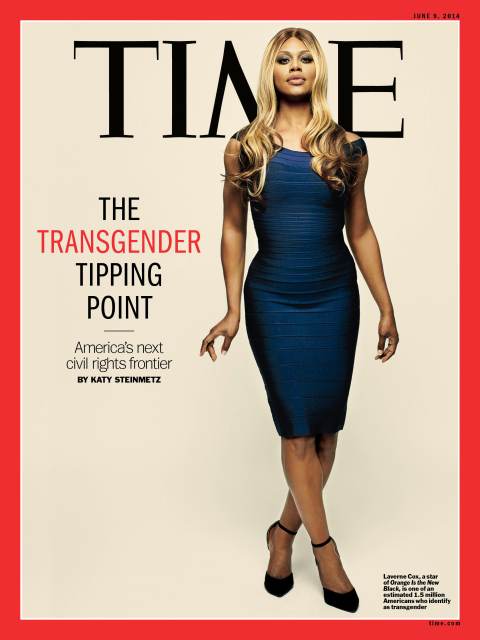As many of you know, I spent last week up on a mountain surrounded by 300 fellow queer Autostraddle staff members and readers at A-Camp. When you’re up there, it can seem like the rest of the world stops spinning, like the only things that are happening are happening at camp. I was reminded just how untrue this is about fifteen minutes before I started a workshop, poetically enough, on how to make queer women’s spaces better for trans women, when Morgan turned to me and said, “Well, her name is Caitlyn.”
I talked to Senior Editor Yvonne about how we should cover the news. With limited access to wi-fi and limited time, Yvonne’s neutral three paragraph, one hundred word article on Caitlyn Jenner’s debut was what ended up happening. That’s all we wrote and, in my opinion, that’s all we needed to write. We acknowledged that the cover debuted and made a place for readers to talk about it, but we didn’t act like it was the Transgender Tipping Point or anything.

As you can see, I now need to write a little bit more.
One of my jobs as Trans Editor here at Autostraddle is to curate submissions that are about trans topics. I’m always telling people that I’m looking for more submissions (especially from Black trans women and other TWOC) and that’s very true right now. In just the few days since Jenner made her debut, I’ve received the same number of submissions that I’d received in the entire two months previous. All of these submissions were about Jenner.
One of my other jobs is to watch the internet and see what kinds of things are being written about trans women and see which things we should be on top of or which things we need to respond to. Again, as soon as I got back from camp, everything started coming up Jenner.
For reasons that are pretty obvious (and some that I’m going to go over here) I don’t want to turn Autostraddle into The Caitlyn Jenner show for the next few weeks. My number one priority as the Trans Editor is trans women of color and especially Black trans women. If we keep on writing about Jenner, a wealthy white celebrity, we can’t do that.
I’d much rather publish articles about Laverne Cox, Janet Mock, Miss Major Griffin-Gacy, Lexi Adsit, Ryka Aoki, Reina Gossett, Angelica Ross, Luna Merbruja, and other trans women of color who are making real differences in the lives of trans women. I’d much rather publish first person essays from trans people who want to share their stories. I’d much rather write about the importance of knowing the names and history of trans women of color. I know we need to do better, and we’re always trying to do just that (Hey trans people, especially TWOC, please submit your essays to me and let me know about stories that I should write about. We pay!).
But when the entire country is devoting rapt attention to one famous white trans woman, well, I should probably say something about that, too.
First, I want to get a couple things out of the way. Number one: I’m happy for Jenner. I’m happy that she’s able to be herself and and that she no longer has to hide. I’m happy that cis people are going to learn more about trans people and form some empathy for us. I’m happy for the trans people who will be helped and inspired by Jenner’s coming out. I also completely realize that, largely because cis people have said it is, this is a big moment for trans people. Jenner is the most famous trans person in America. More people than ever can name a trans person, more people than ever have read or heard a trans person tell their story. As soon as she was on the cover of Vanity Fair (or maybe as soon as she talked to Diane Sawyer), Caitlyn Jenner became the face of the transgender community in the United States.
Apart from being a big moment, this is also a pretty strange one. It’s strange that a trans woman who, so far, hasn’t done any work in the trans community has been crowned our queen. It’s strange that a trans woman who is famous, rich, white and conservative, four things that do not describe most trans women, is now the face most cis people think of when they hear the word “transgender.” It’s weird that people are saying that famous, rich, white, conservative and conventionally attractive trans woman is humanizing trans people to a whole new group of people. Why didn’t Janet Mock or Laverne Cox do that for them? Why didn’t CeCe McDonald? Why didn’t Islan Nettles?

The fact that it took a rich, white trans woman to humanize us probably doesn’t come as a shock to most trans women of color — or to most women of color, period. When we see our friends and sisters being arrested, raped and murdered on such a regular basis, we already know that our humanity isn’t being recognized (I say “our,” because I am a trans Latina, but I also need to say that my father is white and I often pass as white, so I’m definitely not dehumanized or brutalized in the way that darker-skinned and black trans women are). So to hear that Jenner’s coming out is finally “humanizing” trans people feels like cis people are rubbing salt in wounds that they’ve given us.
While most thinkpieces written by trans people do point out problems with having Jenner as the “face of the trans community,” since the day she first told Diane Sawyer that she was trans, some white trans people have been joining in to say that Jenner’s coming out was the moment we needed to finally humanize us. Many white cis and trans people have been coming together to once again disregard the visible and tireless work of TWOC. This moment that cis people are saying is galvanizing us is actually making many of us feel even worse.
It’s also strange that a lot of pretty respected news organizations are using Jenner’s coming out as an opportunity to release statements of trans misogyny as “opinion pieces.” Or maybe “strange” is the wrong word, because really, we should be used to it by now, but it still feels wrong.
One of the highest profile “opinion” pieces was written by Elinor Burkett for the New York Times, entitled “What Makes a Woman?” The piece trots out many of the same old arguments made by trans-exclusionary feminists for decades, the very same arguments that necessitated the creation of the term “transmisogyny” in the first place, a term that differentiates acts of discrimination, violence and oppression that trans women face from ones that trans men face on the basis that womanhood and femininity are seen as less valuable than maleness and masculinity, and so trans women and transfeminine people are targeted specifically because we are trans and because we are women.
Burkett argues that Jenner’s interpretation of “womanhood,” which Burkett defines with scorn as “a cleavage-boosting corset, sultry poses, thick mascara and the prospect of regular “girls’ nights” of banter about hair and makeup,” puts “women — our brains, our hearts, our bodies, even our moods — into tidy boxes, to reduce us to hoary stereotypes.” She says the idea that a gendered identity is “encoded in us” is “nonsense that was used to repress women for centuries.”
There’s so much going wrong here I don’t really know where to start. Okay, how ’bout here: she misgenders Jenner and other trans people throughout, reinforcing her original statement that trans women aren’t real women. She doesn’t even attempt to be polite about it: she uses Jenner’s birth names, “he” pronouns, and refers to how she just “became” a woman. She uses this singular trans woman, then, to represent all trans women, a group she argues against for the rest of the essay.
She also uses phrases like, “female students who consider themselves men,” showing that she and the editors of the Times had no interest in looking at GLAAD’s guidelines for talking about trans people. I know what the Dallas Morning News says (not just once, but twice), but it’s really not that hard to trust that trans people know who and what we are and to use the correct names and terminology for us.
She claims trans women have no awareness of what it’s like to be a woman, claiming we don’t know what it’s like to be afraid while walking alone at night (despite the fact that trans women who dare to walk anywhere alone are exceptionally vulnerable to harassment, assault and even murder) or how it feels to be paid less than men. To Burkett, we’re just the next “men” in line trying to tell women how to feel and think while reinforcing a damaging gender binary. I guess Jenner has humanized trans people for Burkett, but instead of seeing a human being she can empathize with, she just sees a human that she doesn’t really like.
I could go on, but I won’t: like I said, her arguments aren’t anything new, nor are the rebuttals to them. But they were presented to the world as new, untested — and progressive — ideas because the world was paying attention to Caitlyn Jenner.
While Jenner has created a brand new level of visibility for trans people, that visibility has definitely come with a price. Because so many more people are interested in reading articles about trans people, so many more people (including many who have very little knowledge about trans issues or people) are willing to very publicly share their opinions, and be heard. In Burkett’s case, rather than question her own misogynistic judgements about the value of a feminine gender presentation or the agency of women who choose those things (because apparently those of us who like makeup and dresses are just buying into a “tidy box”), or question why the media seems only comfortable with very feminine-presenting trans women to begin with, she goes after trans women themselves. As if we aren’t already vulnerable enough. (Caitlyn Jenner, specifically, aside.)

There have also been some really amazing responses to Jenner’s coming out, many of them, not surprisingly, written by trans women of color. Janet Mock wrote an incredible blog post that not only outlines Jenner’s various privileges but also talks about how trans coverage is changing now and how we should react to that. She talks about how in the one hour after Jenner made her debut, she received more media “requests than I have received from the release of my book, the release of Laverne Cox’s TIME cover, my infamous CNN debate and the consistent deaths of trans women of color — combined.” Again, cis society is deciding that this is the issue that they finally want to pay attention to.
Cox herself also added her own thoughts via a tumblr post that largely talks about Caitlyn’s glamorous photo spread and look. Cox talks about how Jenner’s look isn’t the norm for trans women, Cox’s isn’t even, and that “this is why we need diverse media representations of trans folks to multiply trans narratives in the media and depict our beautiful diversities.” Both women were spot on. Jenner’s debut was an auspicious one, but we need much more representation and we need to be recognized for much more of the things we’re already doing.
Every year on Trans Day of Visibility I see two kinds of essays. One kind, usually from white trans people, talks about the importance of visibility. The other kind, usually from TWOC, talks about how for black and brown trans women, being visible often means being open to violence and discrimination. I see the value and truth in both. Jenner’s extremely visible debut in Vanity Fair is showing this duality perhaps better than any previous mainstream trans story.
So we here at Autostraddle aren’t going to pretend that Jenner coming out is going to improve every trans woman of color’s life or even every white trans woman’s life. We’re not going to act like she’s the hero the trans community has been waiting for; we already have plenty of heroes we need to pay more attention to. At the very same time that people are claiming that Jenner is doing so much good for the trans community, one of those heroes, Monica Roberts — one of the most important trans writers on the internet — is having to ask for donations on her website. If that doesn’t illustrate the huge gap between the experiences of trans women, I don’t know what does.
There has to be a better way to talk about the trans community (whatever that means) after Jenner’s coming out than to frame everything in reference to her. So that’s what we’re going to do. We’re not going to be publishing articles about Jenner every other day or even every week. We’re not going to keep talking about how things are “so different and so much better” now that Jenner is out. We’re going to keep trying to do better and we’re going to keep trying to focus on trans women of color. Caitlyn Jenner might have humanized a very specific type of trans person in the eyes of cis people, but until black trans women have their humanity recognized in the same way, forgive us if we feel like we still have a lot of work to do.




